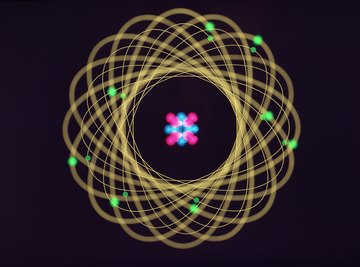
Of the four natural forces, known as the strong, weak, gravity and electromagnetic forces, the aptly named strong force dominates over the other three and has the job of holding the atomic nucleus together. Its range is very small, however -- about the diameter of a medium-sized nucleus. Amazingly, if the strong force worked over long distances, everything in the familiar world -- lakes, mountains and living things -- would be crushed into a lump the size of a single large building.
Atomic Nucleus and the Strong Force
Every atom in the universe consists of a nucleus surrounded by a cloud of one or more electrons. The nucleus in turn contains one or more protons; all atoms save hydrogen have neutrons also. The strong force causes protons and neutrons to attract each other so they stay together in the nucleus; however, they don’t attract the protons and neutrons of neighboring atoms because the strong force has little effect outside the nucleus.
The Strong and Electromagnetic Forces
Protons are particles with a positive electric charge. Because like charges repel, protons experience a repulsive force as they approach each other, and the force increases rapidly as they get closer. The electromagnetic force that produces the repulsion acts over large distances, so unless some other force acts on the protons, they don’t touch each other. Neutrons, on the other hand, have no charge; free neutrons move about unhindered. When protons and neutrons come within about one trillionth of a millimeter, however, the strong force takes over and the particles stick together.
Particle Ping Pong
The modern theory governing the four fundamental forces proposes that they are the product of back-and-forth exchanges of tiny particles, much as in a game of ping-pong. In this game, the Heisenberg Uncertainty Principle sets the rules -- heavy particles can move between short distances, whereas light particles reach long distances. In the case of electromagnetism, the particles are photons, which have no mass; the electromagnetic force extends to an infinite distance. Very heavy particles called pions mediate the strong force, however, so its range is extremely short.
Nuclear Fusion
Gravity holds the sun and other stars together; the huge mass of hydrogen and helium gas produces gigantic pressures in the core, forcing protons and neutrons together. When they come close, the strong force comes into play and they stick together, releasing energy in the process and transforming hydrogen into helium. Scientists call this a fusion reaction, and it produces 10 million times as much energy as chemical reactions such as burning coal or gasoline.
Neutron Stars
A neutron star is the remnant of an explosion that occurs at the end of the star’s life. It is an ultra-dense object, consisting of a star’s mass compressed into an area the size of Manhattan. In the neutron star, the strong force dominates because the explosion has forced all the protons and neutrons together. The star has no atoms; it’s become a big ball of particles. Because atoms are mostly empty space, and the neutron star has all the space squeezed out, its density is enormous. A teaspoonful of neutron star matter would weigh 10 million tons. Because the Earth is made of atoms, if the strong force somehow suddenly acted at long distances, all the protons and neutrons would clump together, resulting in a sphere a couple hundred meters in diameter and having all of the Earth’s original mass.
References
About the Author
Chicago native John Papiewski has a physics degree and has been writing since 1991. He has contributed to "Foresight Update," a nanotechnology newsletter from the Foresight Institute. He also contributed to the book, "Nanotechnology: Molecular Speculations on Global Abundance." Please, no workplace calls/emails!
Photo Credits
Jupiterimages/Photos.com/Getty Images
